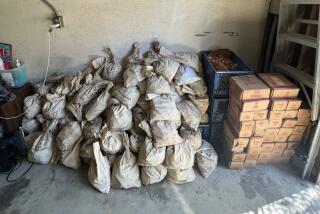Toning Process May Enhance the Value
- Share via
Question: Your caution regarding not-quite-honest coin dealers prompts this letter. While going through my mother’s things after her death, I found a pile of coins stuck in a very old tin. The tin was lined with satin and the coins covered with a satin cushion so that very little air got to them. Some of them are undoubtedly common European coins brought back by my father after World War I. But there is a large copper coin dated 1844 and a tiny silver coin dated 1880. What, if anything, should I do about the corrosion? Now that they have been more exposed to air, will it worsen? I am in Bakersfield. Can you recommend a list of coin dealers?--V.B.
Answer: I suspect your copper coin is a large cent, a series that was issued from 1793 to 1857. The tiny silver coin is most likely a nickel 3-cent piece, a series that was issued from 1865 to 1899. The corrosion that you describe is probably the natural toning process at work. Many collectors believe that toning enhances the value of a coin and contributes to its beauty.
Now, what should you do about this condition? Absolutely nothing. More coins are ruined by cleaning or attempted cleaning than are improved. Cleaning is never recommended.
Occasionally experts will tinker with coins in an attempt to improve their eye appeal. This is usually detectable and it only fools or misleads the unknowledgeable. Exposure to air (and the other elements) will contribute to toning, but I wouldn’t be concerned at this time.
It’s best not to handle your coins. And, if you wish to preserve them, airtight plastic holders are available.
As for dealers, I don’t recommend any in particular. Check with more than one in order to determine the best way to proceed.
Q: I have a bill, Dominion of Canada 25-cent paper money dated Jan. 2, 1900. Any information you can give me?--M.H.
A: Your Canadian bill is known as fractional currency. It’s worth about $5.
Q: I have a roll of 1955-S uncirculated wheat pennies. Are they worth anything? Should I save them for my grandson (who is 17 years old)?--D.L.
A: Your roll of uncirculated wheat cents (face value $1) is worth about $12. Whether you should sell now or keep the coins for your grandson is anyone’s guess. No one knows the future. You might do just as well or better putting the $12 in the bank and letting the interest compound. This is not necessarily the case with investment-quality coins, which have shown remarkable appreciation over the years.
Coin News
Gold continues among the leaders in the coin market. A new work on the subject is in the works. “Buyer’s Guide to United States Gold Coins” by Q. David Bowers will analyze U.S. gold pieces by denominations and pinpoint those that have been overlooked for their appreciation potential. Thousands of auction records have been analyzed and compiled in table form. The 120-page book (pictured) is available in paper for $12.95 and in hardback for $19.95 plus $2 for postage and handling from Bowers & Merena, Box 1224-NR, Wolfeboro, N.H. 03894.
The 1989 uncirculated set is now available for $7 from the United States Mint. There are 10 coins included in the set, five each from the Philadelphia and Denver mints. Sets contain the Lincoln cent, Jefferson nickel, Roosevelt dime, Washington quarter and Kennedy half dollar. The 10-coin set has a face value of $1.82. Order from the United States Mint, P.O. Box 13575, Philadelphia, Pa. 19101-3575. For information, contact the Customer Service Center, United States Mint, 10001 Aerospace Drive, Lanham, Md. 20706; telephone (301) 436-7400.
More than 1,500 items will be auctioned in three sessions at the Hong Kong International Coin Exposition May 18-21 at the Golden Mile Holiday Inn, Kowloon, Hong Kong. It is being conducted by the Money Co. of Tarzana, and mail bids are accepted if they arrive before the auction. Catalogues are $10 from the Money Co., 5959 Tampa Ave., Tarzana, Calif. 91356; telephone (818) 609-7666.


